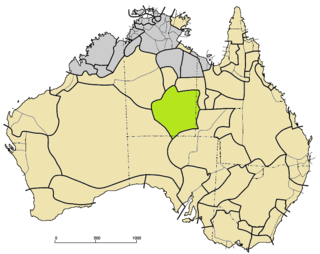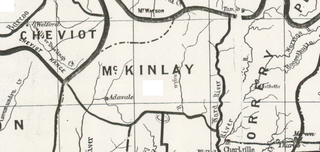The Goreng Goreng, also known Kooreng Gooreng, are an inland Freshwater Australian Aboriginal people of Queensland, and also a language group. The Goreng Goreng area is between Central West Queensland in the north around Boyne Valley, extending westerly as far as the Great Dividing Range along the Dawes, Auburn, Nogo and Callide Ranges to meet the Wulli Wulli and Ghunghulu to their immediate west over the Great Dividing Range.
Yalarnnga is an extinct Australian Aboriginal language of the Pama–Nyungan language family, that may be related to the Kalkatungu language. It was formerly spoken by the Yalarnnga people in areas near the Gulf of Carpentaria the towns of Dajarra and Cloncurry in far northwestern Queensland. The last native speaker died in 1980. It is a suffixing agglutinative language with no attested prefixes.

Arrernte or Aranda or sometimes referred to as Upper Arrernte, is a dialect cluster in the Arandic language group spoken in parts of the Northern Territory, Australia, by the Arrernte people. Other spelling variations are Arunta or Arrarnta, and all of the dialects have multiple other names.
The Anmatyerr, also spelt Anmatyerre, Anmatjera, Anmatjirra, Amatjere and other variations) are an Aboriginal Australian people of the Northern Territory, who speak one of the Upper Arrernte languages.
Yandruwandha is an Australian Aboriginal language of the Pama–Nyungan family. Yawarawarga is considered a dialect by Dixon (2002), a closely related language by Bowern (2001). It is also known as Yawarrawarrka,Yawarawarka, Yawarawarga, Yawarawarka, Jauraworka, and Jawarawarka).
Kungkari is an extinct and unclassified Australian Aboriginal language. The Kungkari language region included the landscape within the local government boundaries of the Longreach Shire Council and Blackall-Tambo Shire Council.

The County of Flinders is a county in Queensland, Australia, located in the Central Queensland region between Gladstone and Bundaberg. The county is divided into civil parishes. It was named for Matthew Flinders who explored the Australian coastline.
Gavan Breen, OAM, also known as J.G. Breen, is an Australian linguist, specialising in the description of Australian Aboriginal languages. He has studied and recorded 49 such languages.
The Tulua people were an Aboriginal Australian people of Queensland, in the southern to central region from the coast to the ranges. The Dappil and Tulua people possibly spoke the same language.
The Goeng or Gureng were an Aboriginal Australian people of the state of Queensland. They lived in the area of the area of present-day Gladstone.
The Wadjabangai, otherwise known as Wadjabangayi, were an indigenous Australian people of Queensland.
The Wadjalang, also known as the Dharawala, were an indigenous Australian people of Queensland.
The Kulumali were an indigenous Australian people of the state of Queensland.
The Marulta were an indigenous Australian people of the state of Queensland, Australia.
The Yalarnnga, also known as the Jalanga, are an Indigenous Australian people of the state of Queensland.

Kyabra County, Queensland is a cadastral division of Queensland and a County of the South Gregory District of south western Queensland.
Burrandilla County is a cadastral division of Queensland and a County of the Warrego Land District of south western Queensland. The county is divided into civil parishes.

McKinlay County, Queensland is a cadastral division of Queensland and a County of the Warrego Land District of south western Queensland.
Cameron County, Queensland is a County of Queensland in Australia, in the South Gregory District Land District.
Gowan County, Queensland is a cadastral division of Queensland and a County of the Warrego Land District of southwestern Queensland in Australia.




